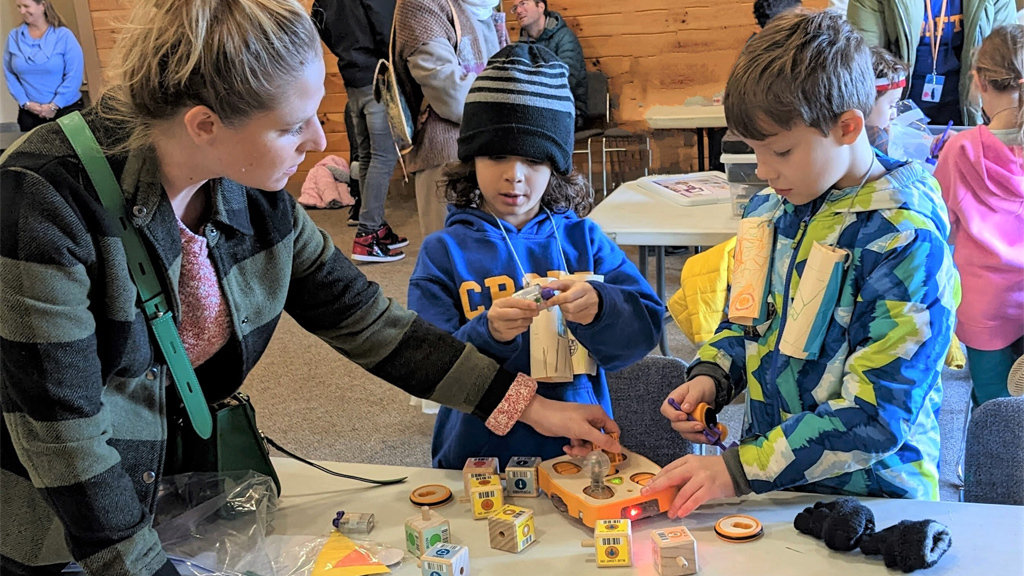Emerging Connections
From Birding to Robotics: Integrating STEM Learning Through Community Collaboration
As technology advances, an increasing number of elementary students are finding inspiration in STEM subjects, especially robotics and coding. This interest has led to an engaging service learning project taught by preservice teachers hosted at a nearby nature center. Elementary students from an urban independent school joined with nature center educators and robotics experts to use the engineering design process to mimic nature using coding robots as shown in Figure 1. What inspired these young engineers to take on this challenge? A closer look at the birds outside provided the perfect motivation.
This article exemplifies the transformative power of community collaboration, as STEM education meets real-world, hands-on life science, inspiring the next generation of young minds to "soar" to new heights. This project combines the wonders of birding with the limitless possibilities of robotics, igniting a spark of excitement in STEM education. This study investigates the effectiveness of connecting integrated STEM learning with nature-based experiences, with the ultimate goal of enriching elementary students' learning and extending their knowledge of integrated STEM topics. Although we focused on birds and robotics for our project, our template could be adapted for just about any topic and any location—even remote learning! Wherever you are coming from, whether it is urban, suburban, or rural, K–12, college, or non-traditional education, reaching out to the community is beneficial for all partners involved.

Integrated STEM: Why Is It Important?
According to the 2018 National Survey of Science and Mathematics Education, K–3 students were taught science for an average of 18 minutes a day, while they spent 89 minutes on English language arts and 57 minutes on math (NSSME 2018). Few elementary classrooms integrate STEM into their daily curriculum, and even fewer integrate coding and robotics. Although STEM resources are beginning to be created and shared, many elementary teachers face challenges when they try to include coding and robotics in STEM integration.
This is concerning because recent evidence highlights the elementary years as a time to build a foundation for later science achievement (Curran and Kitchin 2019). Not surprisingly, the current approach to teaching STEM in the elementary grades has not been effective, as evidenced by the latest National Assessment of Educational Progress (NAEP), the gold standard in student assessments otherwise known as the Nation’s Report Card (Goodner 2021). Results from the 2019 NAEP Science Assessment showed that the national science scores have decreased at fourth grade compared to 2015 (2019 NAEP Science Assessment).
Research by Kidd et al. (2020) found that despite a recent push for STEM education in the United States, many elementary students fail to receive effective integrated STEM education in their classrooms. They also note that, in spite of nationwide calls to integrate engineering and coding into PreK–6 education, schools face a lack of teachers who have the knowledge and interest to integrate robotics, coding, and engineering into mainstream subjects. There are programs outside of the classroom that include trained professionals who can help support teachers and preservice teachers in their endeavors to teach integrated STEM in their classes. These programs include—but are not limited to—museums, science enrichment programs, and local nature centers. Integrating robotics and engineering into these programs is another important step needed in education to enhance student engagement and STEM learning outcomes.
Blackley and Howell (2019) state that the use of robotics in the elementary classroom, “authentically engages students in what we refer to as head-heart-hands learning: head—cognitive demands and intellectual engagement; heart—enthusiastic engagement and development of interpersonal skills; hands—fine motor skills and spatial reasoning” (pp. 61–62). The authors noted that students constructing robots are actually building mechanical systems, which helps them develop a deep understanding of how the components work together and how their functionality can be changed. Some of these positive effects of coding and robotics integration include comprehension of STEM concepts (Yilmaz et al. 2013) as well as improvements in problem-solving and higher-order thinking skills (Blackley and Howell 2019). Put simply, “effective STEM education is vital for the future success of students…the preparation and support of teachers of integrated STEM education is essential” (Stohlman et al. 2012, p. 5).
Service Learning Project: Birding With Robotics
Growing up on the shores of New England sparked a passion in me for marine biology and science in general. I also knew I wanted to be a teacher from a young age, so STEM education has been the perfect fit. I have taught children and adults in formal and informal settings as a STEM specialist and STEM coach. Currently, I teach preservice teachers at a university located in the northeast.
Recently, I had the opportunity to partner with a nature center, a local robotics company, and a group of second graders from a local independent elementary school to create a service learning project with preservice teachers. By connecting these organizations, we brought new learning experiences to the community surrounding the university where I work. The lesson integrated coding and robotics with life science standards and outdoor education, focusing on animal adaptations and the engineering design process.
I currently teach a coding course for preservice teachers where we use many types of robotics, including a variety of screen-free robots. The screen-free KIBO robots we used for this collaborative project were specifically created for education settings and do not require a screen. Students program the KIBO robot by creating sequences of wooden blocks with scannable barcodes that correspond to programming commands such as forward, backward, turn, and repeat. Students then use the body of the KIBO robot itself to scan their block sequences to have the robot act out their programs. The top of the KIBO robot has a platform for students to build on, so they can make it into any character, animal, or vehicle that they choose. The array of interactive sensors and extensions, which include dark/light sensors, sound sensors, recording devices, lightbulb attachment extensions, and distance sensors, are easily coded and manipulated by young students. Preschoolers can find success with simple commands, while older students can design more complex sequences.
For my service learning project, my goal was to give elementary students the opportunity to connect the learning they are doing in school to STEM experiences outside of school, incorporating robotics and coding while meeting the second-grade NGSS science standards. I also aimed to give preservice teachers the opportunity to not only practice writing lessons with technology integration, but also use these robots with young children to build experience and confidence in integrating STEM into the elementary curriculum. Figure 2 includes the preservice teachers who helped create and teach the Birding with Robots part of the program.
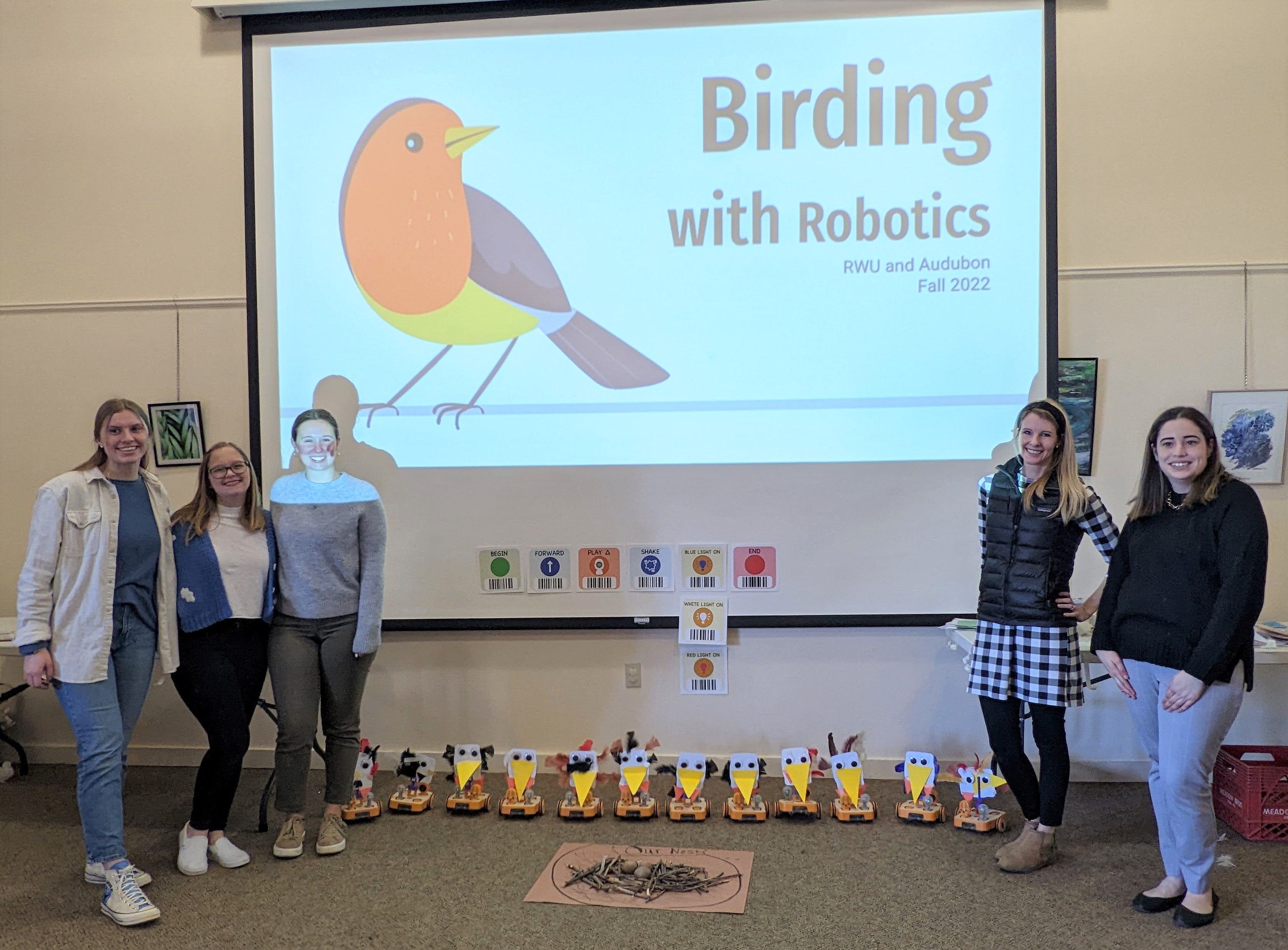
Partners and Motivation
I am so grateful for the support, commitment, and participation of local organizations that were enthusiastic to be a part of this project. Every group that we worked with had a similar passion for connecting in-school and out-of-school elementary STEM learning. Our project’s objectives aligned with each partner's missions and goals to support student learning and growth through STEM education. Table 1 offers a detailed look at each of the organizations and their commitment and participation in this project. Each local partner is further described below.
Nature Center
This nature center is home to a natural history museum featuring interactive exhibits that explore habitats and wildlife found in the state and includes a small aquarium located on a beautiful nature reserve. The center offers guided walks, birding classes, lectures, and family and student programs. Their goal is to provide hands-on science programming in classrooms as well as in wildlife refuges and at their nature center and aquarium. The nature center educators were intrigued and enthusiastic about the prospect of this collaboration integrating robotics and coding at their center.
Robotics Company
Another key collaborator, KinderLab Robotics, is a local robotics company that invented KIBO robot kits for young children and is fully dedicated to achieving universal STEAM literacy by getting even the youngest learners excited about science, technology, engineering, art, and math. Backed by more than 20 years of research by a child development and technology expert, the screen-free coding robots, which we used for our project, are specifically designed for engaging students in preschool through fifth grade in STEM integration programming. To program the robots, students create their code by arranging wooden blocks in the order they choose to accomplish a task. They then scan the barcodes on the blocks into the robot itself. Similar to block coding on a computer, the robots will act in the order of the scanned blocks.
University
The third partner in this collaborative service learning project is the university where I teach STEM education courses. This university’s mission states to “strengthen society through engaged teaching and learning” by helping students develop the knowledge and skills they need to make positive contributions to the world around them. The innovative STEM minor provided at the university benefits undergraduate students by offering hands-on STEM integration and teaching them 21st-century STEM skills. The preservice teachers who co-taught this integrated STEM lesson to second graders were well trained in STEM methods, pedagogy, and instructional design by the professors in the School of Education at the university.
Elementary School
The local elementary school that we partnered with is an urban independent school located in a densely populated city. This school encourages their diverse student population to develop their skills in problem-solving and become lifelong learners with strong academic passions as well as a sense of themselves and their purpose. The project-based school puts STEM at the forefront of their education, encouraging their students to be outside in nature through field work experiences and collaborations, such as the one with the local nature center.
Program Development
The program development of this lesson called Birding with Robotics, stemmed from collaboration among all of the partners listed above. The topic, school, and grade level were chosen by the nature center. The nature center educators suggested a life science lesson that would align with their expertise, on-site animals, and resources about birding that led us to envision an immersive outdoor experience on the property, observing the wide array of birds at the nature center. Teachers from the elementary school suggested focusing on life science standards that most aligned with the topics that they were currently teaching in the second-grade class. The robotics company shared lessons that they have previously done with the KIBO robots. They also shared resources specifically about the KIBO robots for the preservice teachers to use for lesson creation. The university provided us with a class set of KIBO robots that belong to the university’s School of Education. The preservice teachers at the university came up with how to connect the robots to the standards, the topic, and the grade level. In the coding course, the preservice teachers experimented with different ways to transform the robots into bird models, by adding and coding bird features and behaviors following the second-grade life science standards. The result was a 1.5-hour second-grade integrated STEM lesson (Figure 3) aligned to NGSS (see Google Slides Presentation of Lesson).
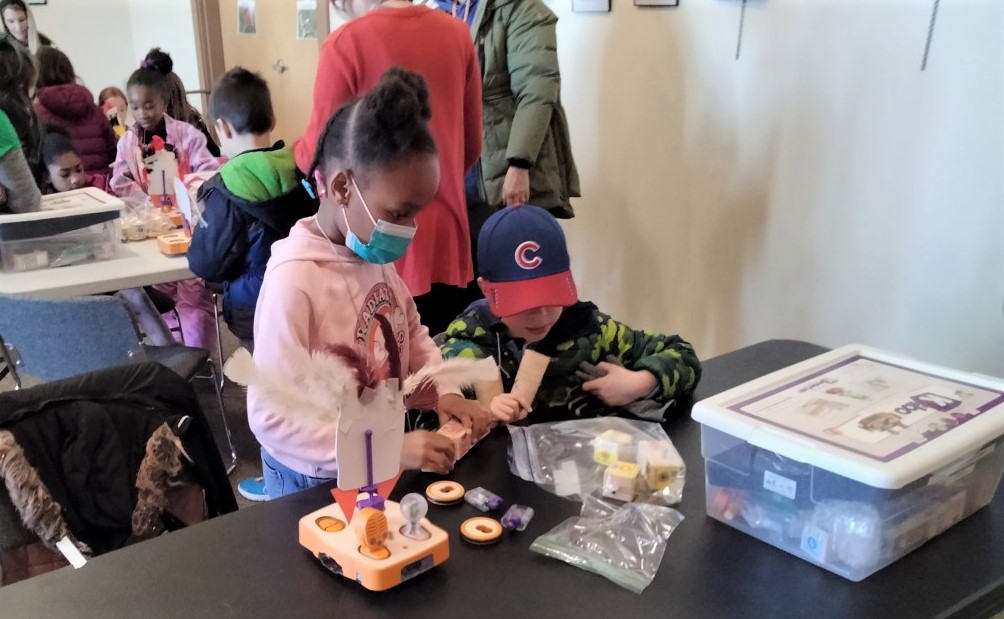
The Curriculum: Birdwatching Followed by Bird-Building
Even before the start of the program, students were working on the in-school and out-of-school STEM connection. A week before the program, the nature center sent the elementary school a binocular worksheet on how to build bird-watching binoculars. The classroom teacher prepped the students for the program by introducing the topic and creating the binoculars made from recyclables with the students.
The program began inside the nature center with a brief introduction to the lesson. The preservice teachers talked with the second-grade students about using their senses to find and observe birds in nature during the first part of the lesson, a birding nature walk. Students were asked to pay specific attention to the features of the birds that they observed. To begin, the nature center’s educators showed the students bird photos to demonstrate how birders tell one species from another through shape, color, and special features, such as crests or long beaks. This introduction was followed by a nature walk around the center’s trails, guided by the nature center’s staff for students to make their observations. Students used the binoculars that they created earlier that week in class to observe the birds in their natural habitat. We also encouraged students to look for evidence of bird nests.
For the second part of the lesson, students innovatively demonstrate what they had learned about the local birds they observed (Figure 4). We offered students two challenges:
- Work in pairs to turn their robots into a specific bird that they observed in nature, including realistic color choices for feathers, recorded bird call, and lightbulb color for the bird’s body. For this challenge we used craft materials and the robot’s sound recording and lightbulb extensions, which can be programmed to be white, blue, or red to best match the bird’s coloring. Students also used masking tape, feathers, pipe cleaners, paper triangles for beaks and feet, paper for eyes, and twigs to make nests.
- Work collaboratively to code the robots to build a class nest. The robots were programmed to mimic the bird’s movements. Partners—divided into twig gatherers and nest builders—helped create this nest by collecting twigs from around the classroom, placing the twigs on the robots, and coding the robots to bring the twigs to the class nest (Figure 5).


Data Collection
To evaluate whether the program achieved our goal of successfully integrating STEM learning with robotics, both for the elementary students and the preservice teachers, we collected qualitative data using several surveys and reflection questions from all the community members involved. This included the nature educators, the robotics company’s curriculum developer, the elementary teachers, the preservice teachers, and the second graders. We also used photos and videos to make informal observations of students and the preservice teachers to capture how they interacted with each other and engaged with the lesson.
To collect quantitative data from the students who participated in the robotics lesson, the preservice teachers created an exit ticket with two age-appropriate questions. The first question asked, “Did you like learning with robots?” and the second question asked, “Do you want to learn with robots again?” These questions had yes, no, and maybe answer choices with drawings to identify terms for nonreaders. Students were given two stickers, one to place next to each of the questions to indicate their response. Reading the questions aloud to each student as well as using stickers for the exit ticket provided access to all students, including nonreaders and nonwriters (Figure 6).

Data Analysis and Discussion: Comments and Reflections of Community Partners
Based on data collected from the surveys, we learned that all community members were impressed by the preservice teachers’ ability to work with the students and were also impressed by the excitement and engagement of the partners and students involved. We also found that the community members enjoyed the project and were enthusiastic about participating in more robotics lessons in the future. When answering “What aspects of your classroom curriculum did the [nature center] program support?”, one of the elementary school educators answered, “...students got to go hands-on with robots which is a STEM item we currently don’t have at [our school], and the robots were so simple for students to use … we appreciate the outdoors a ton … what a dream to combine both in one day!” When answering the question “What aspects of this workshop were most useful or valuable?”, the nature center’s director replied, “The connection between the outdoor investigation into birds and the robotics challenge to ‘build a bird’ and then create a nest. I learned about robotics as well!” Feedback from the robotics company’s education curriculum specialist who supported the program included, “The program was so very well executed,” and added that, “After some scanning practice, the children were able to see that what they coded was what was performed! It was great to watch the realization!”
From the videos, pictures, observations, and interactions, we found that students were fully engaged with the lesson. They expressed excitement at transforming the robots into birds and showed enthusiasm when coding the robots to move, make bird noises, light up, and carry twigs for the nest. An email from one elementary school educator following the lesson excitedly exclaimed, “WOW, WOW, WOW! We’re just finishing up lunch and the talk of the bus ride home and all of lunch has been what a great morning we had! Everyone wants their own robot bird :). Thanks for inviting us to share in such a creative and innovative program and we hope many students come to get the opportunity to enjoy that rich knowledge-building!” (Figure 7).
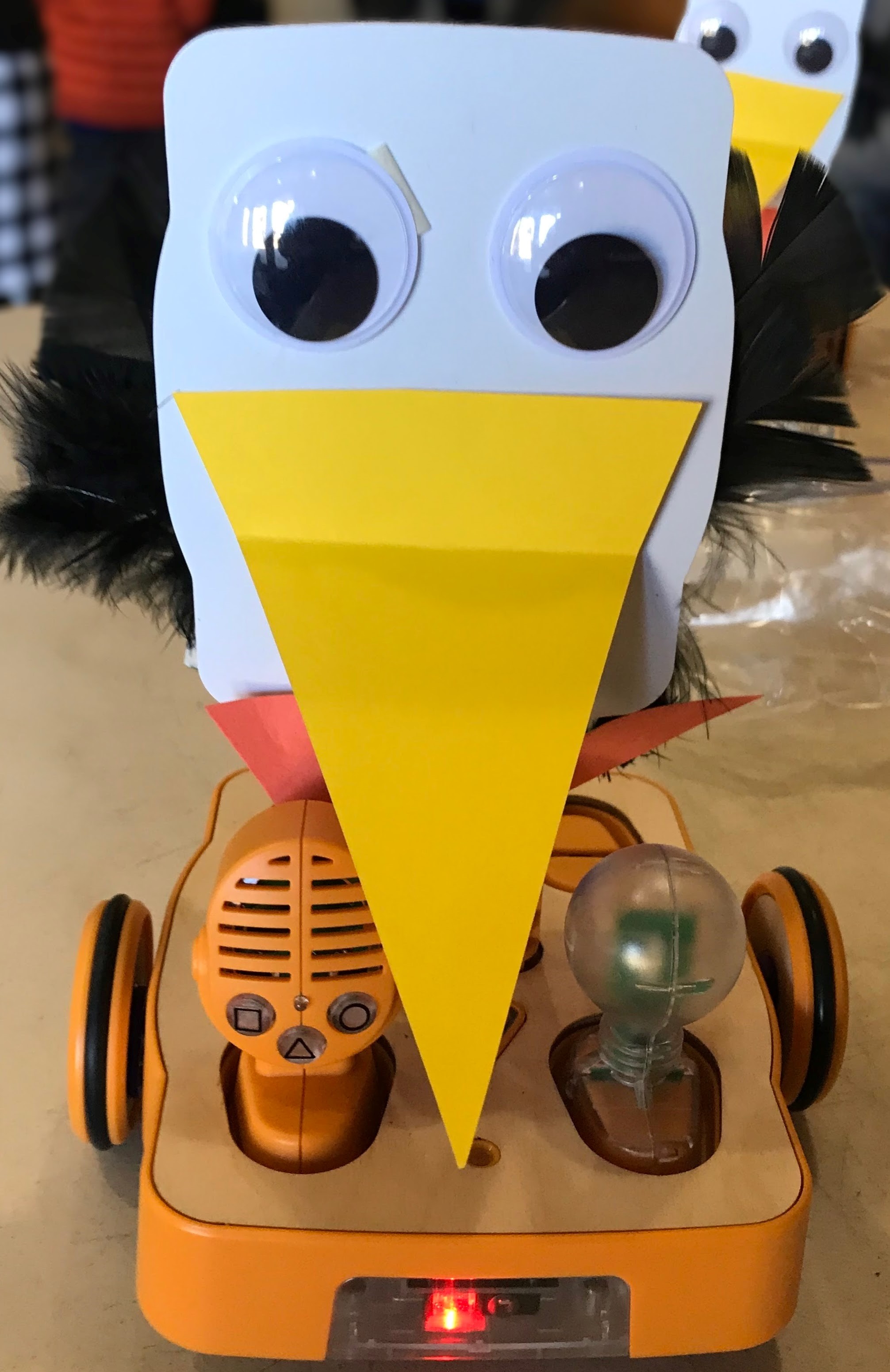
Reflections of Preservice Teachers
In their reflections preservice teachers agreed that practicing integrating coding in a real-world setting was helpful for their future careers. One of the preservice teachers reported, “I officially feel that I am capable of teaching STEAM instruction!” Other responses included, “This helped me learn how to incorporate coding into lessons … I would definitely love to add coding into future lessons after seeing the impact and excitement this left on the students,” and “I saw that it was possible to teach students how to use the robots as well as integrate content in the same lesson, and have students make progress on both elements” (Figure 8).

The preservice teachers also reported on the engagement of students. A preservice teacher noted, “I was so happy to see how much the students enjoyed it and jumped right in with working with the [robots].” Another preservice teacher agreed, “to see how all of the students were able to engage with the [robot] regardless of their needs was an eye-opening experience.” The positive impact of collaboration was also a common theme amongst the reflection answers. A preservice teacher wrote, “Working with the other teachers, including the director from the [robot] company, was an amazing experience learning more about the organization and the robots’ functions.” The reflections before, during, and after the lesson helped the preservice teachers individualize instruction for the diverse second-grade participants and prepare for future integrated STEM lessons (Figure 9).

The quantitative results from the exit ticket showed that 90.5% of students liked learning with robotics and want to learn with robotics again, while 9.5% of students replied, “maybe.” While these findings were informative, the most useful data came from the qualitative data we collected while students completed the survey. As students placed their stickers, we asked multiple students to explain their responses about why they answered how they did. Students who put their stickers on “maybe” to both questions had interesting reasons such as, “I’m sad that we didn’t get more time with the robotics,” “I wish the robot could talk,” (it can, but we did not use that feature that day), and “I wanted to have my own robot that I didn’t have to share.” These qualitative observations paired with the quantitative data painted a clearer picture about what the students were thinking.
Lessons Learned and Challenges
Below, you will find a summary of lessons learned as well as the challenges that we faced during this process. We hope that this information will help other educators, educational leaders, and local organizations create meaningful and impactful in-school and out-of-school STEM connections within their own communities.
Lesson 1: The importance of collaboration
Working with experts from a variety of fields with a common goal of STEM integration was a huge asset to our project. Each educator brought a unique perspective and knowledge. The students benefited from all aspects of the project that were specifically created by experts in various fields. They benefited from the enthusiasm and expertise of the preservice teachers (Figure 10), the real-world connection by the nature center educators, the connection to in-school learning provided by their elementary school teachers, and all the extra materials and lesson ideas provided by the robotics company. The positive partnership between a university, nature center, robotics company, and elementary school created a lasting impact on everyone involved. We are planning more collaborative opportunities in the fall that connect with the curriculum at the elementary school. We will continue to build our relationships with these community partners and seek new ones.

Lesson 2: The value of student engagement with integrating STEM
The second-grade students were completely engaged for the entire program. Learning about the birds first by observing birds in nature helped students become invested in the robotics part of the lesson. The place-based outdoor learning environment was a great hook for student curiosity, and all of the second graders were captivated by the robots and how they were coded (Figure 11). Instantly applying their learning to an engaging project helped students focus on the information and learn as much as they could about the birds, so they could create their own bird robots that had many of the same characteristics as the birds they observed in nature. Connecting to the standards they were learning about in school helped students build on knowledge from their classroom experiences.
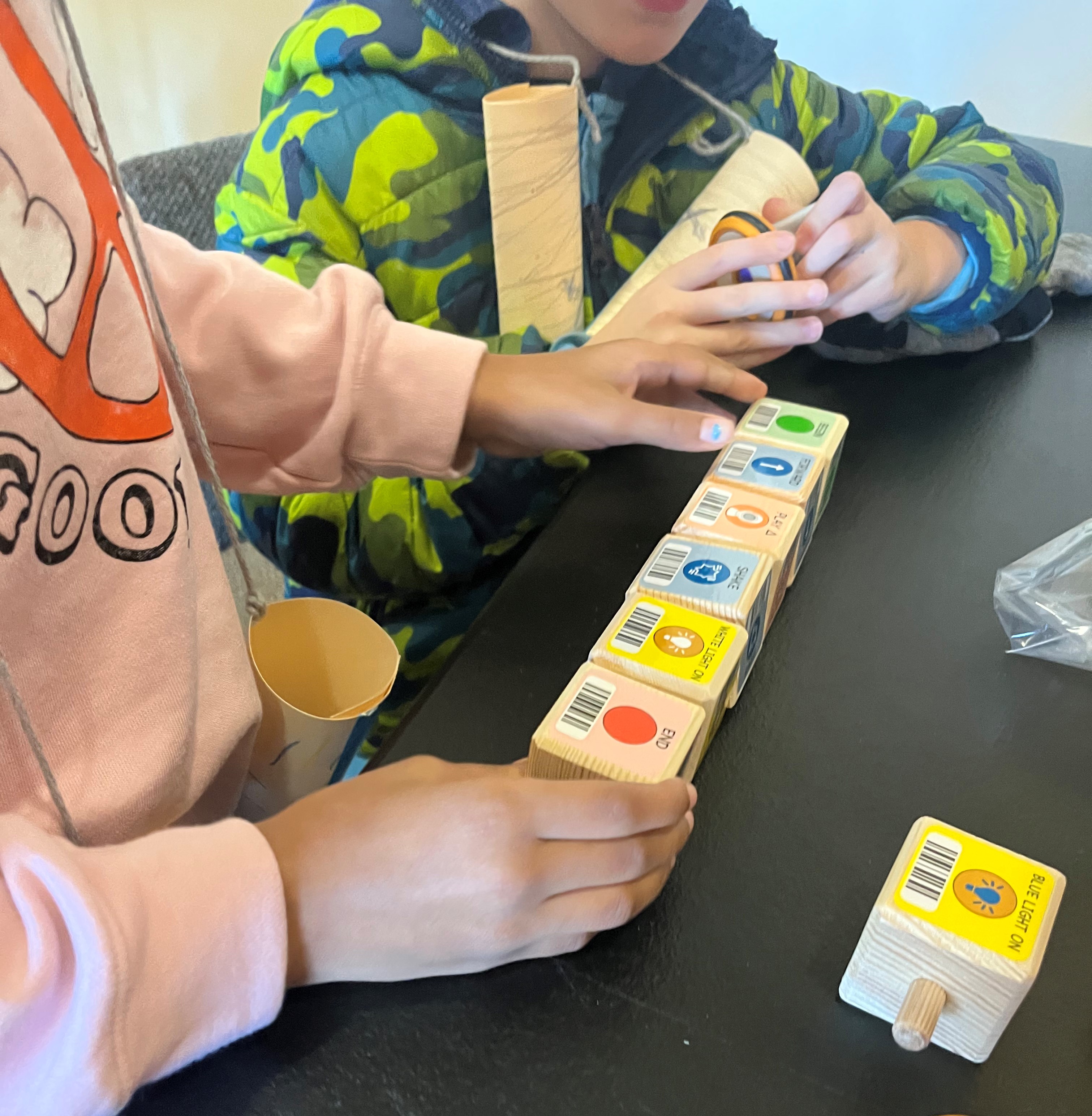
Lesson 3: Materials were integral to success
There were some materials needed for this project that every community might not have direct access to; however, variations of materials could be used in place of the materials we chose. Our university partner has a class set of robots with extensions that we used in the STEM-integrated robotics lesson. The robotics company supplied us with extra robots and extension modules. The nature center supplied materials for learning about birds, including pictures and information, as well as sticks and feathers for creation (Figure 12). The elementary school teachers created individual “binoculars” out of recyclables with their students and brought them to the program to use in the birding activity. The preservice teachers created the slide presentation for the lesson. All partner community organizations were enthusiastic about sharing their assets. The collaborative creation of materials and resources was an important factor of the program’s success.
Lesson 4: Benefits of reflection
Reflection was an important part of this service learning project. It gave every community member an opportunity to reflect, and these reflections were an important part of program evaluation. I incorporated a social justice framework when creating the reflection questions for my preservice teachers and encouraged them to look at this project through a social justice lens to provide critical feedback. I also used two service learning reflection tools—one created by Carrington and Selva (2010) and another by Duke University—to frame my reflection questions and my assessment of the project as a whole. Their prompts helped me look at the big picture to make improvements to create sustainability in this project and to inform future projects. The preservice teachers greatly benefited from using this model of reflection. They could see the growth of their thinking from before, during, and after the program and had the opportunity to reflect on their own childhood experiences before reflecting on their experiences with students in the program.
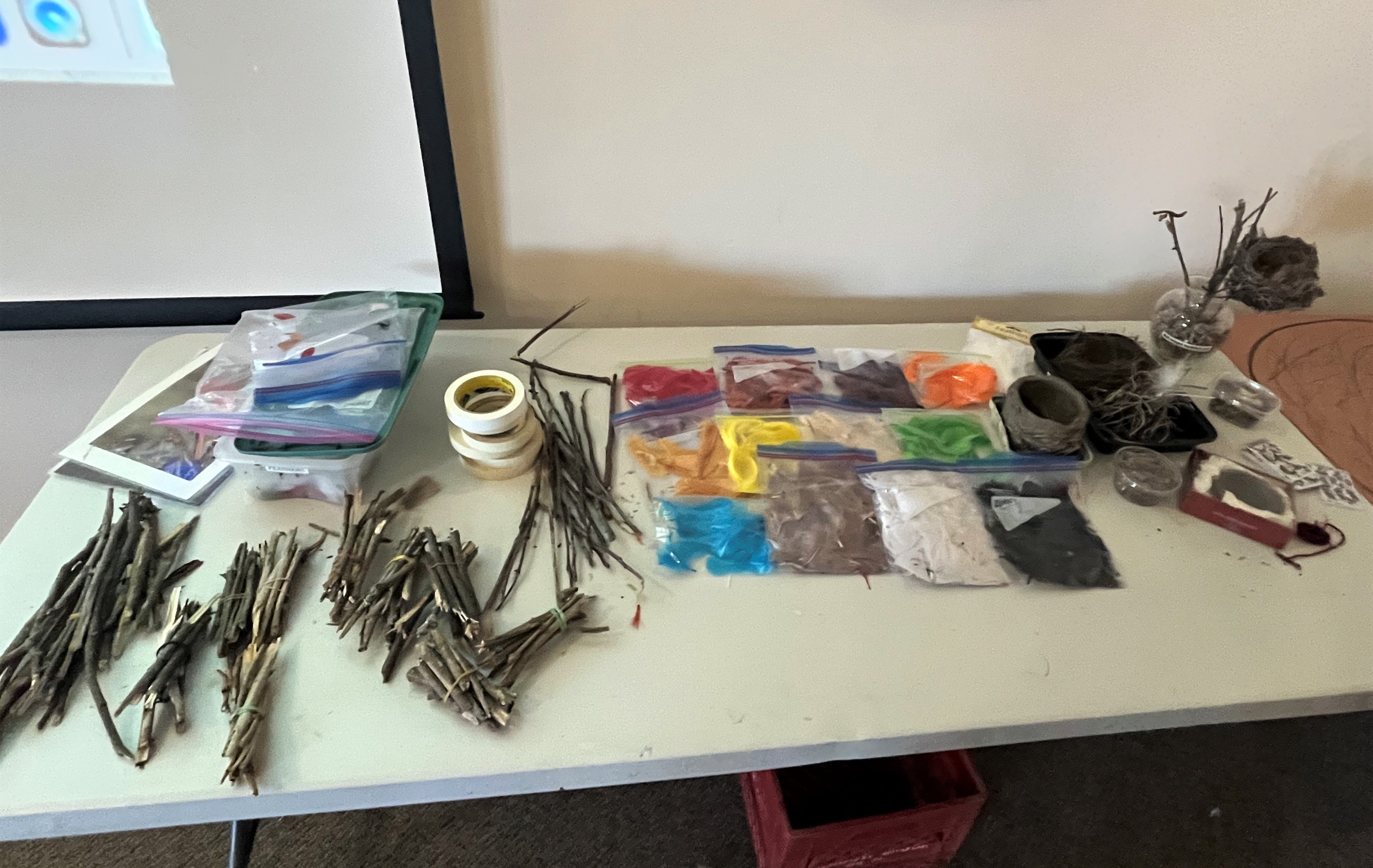
Lesson 5: Planning and prepping
An integral part of this service learning project’s success was being well-prepared. To design the lesson, the preservice teachers incorporated Universal Design for Learning principles, including creating instructional videos and detailed slides with clear visuals. We sent the slides to both the nature center’s director and the robotics company’s curriculum developer for feedback. The preservice teachers then practiced each part of the activity. We packed up kits of exactly what each student would need, including the blocks they were using and craft materials. We also found, cut, and bundled nest materials for each group, and divided the different colors of feathers to put into zip bags. Every minute of the program was carefully created, practiced, and timed. We also had an “if time” plan in case we had extra time. We used the pre-program reflections to guide our thinking in our teaching. Each person in the collaboration had a part that they were prepared to teach or help with. All directions were given to students when they were sitting away from their robots. Having the materials prepared ahead of time made the distribution of items and transformation of robots into birds a faster process. Because of the UDL principles incorporated into each part of the lesson, all students could successfully access the content. Time was allotted for the preservice teachers to plan and practice for the program both during and outside of coding course class hours. Due to our prepping and planning, there was little downtime, so students stayed on task throughout the lesson. All of the preparations ensured teacher confidence and student success.
Challenge 1: Time constraints
Timing will always be a challenge during student learning. Since it was the first time the students had used the coding robots, the second graders were enthralled and needed extra time to play and engage with how the robots work. In the future we will build in extra time for students to experiment with how to work with the KIBO robots before integrating them into a lesson. This might include, for example, a classroom visit by the preservice teachers to the elementary school before the program and a follow-up classroom visit to the elementary school to integrate the robots further into their curriculum.
Challenge 2: Connecting an out-of-school experience to in-school learning
Creating a lesson aligned with an outdoor education center’s NGSS-based curriculum—scheduled during the undergrad semester to line up with exactly what the elementary school was teaching that month—was a challenge of the creation of this program. We did our best to create a lesson that matched learning goals of a second-grade classroom, even if the timing was not exact. When we do this program next fall semester, we will allow more time to connect to the school curriculum by including in-class visits.
Program Impact
The program impact of this project was greater than we expected. According to the teachers at the elementary school, students were making connections from our integrated STEM program to their in-class learning months after the program lesson occurred. The students at this school did not have previous access to robotics, which inspired many students to inquire about future interactions with robotics. They also showed a higher enthusiasm for using coding programs than we predicted. The integrated STEM lesson sparked many students’ curiosity about robotics, leaving them wanting to learn more. Because of this unexpected overwhelming enthusiasm and curiosity, we will be working with this group of students again and bringing integrated STEM lessons to other classes in their school as well (Figure 13).
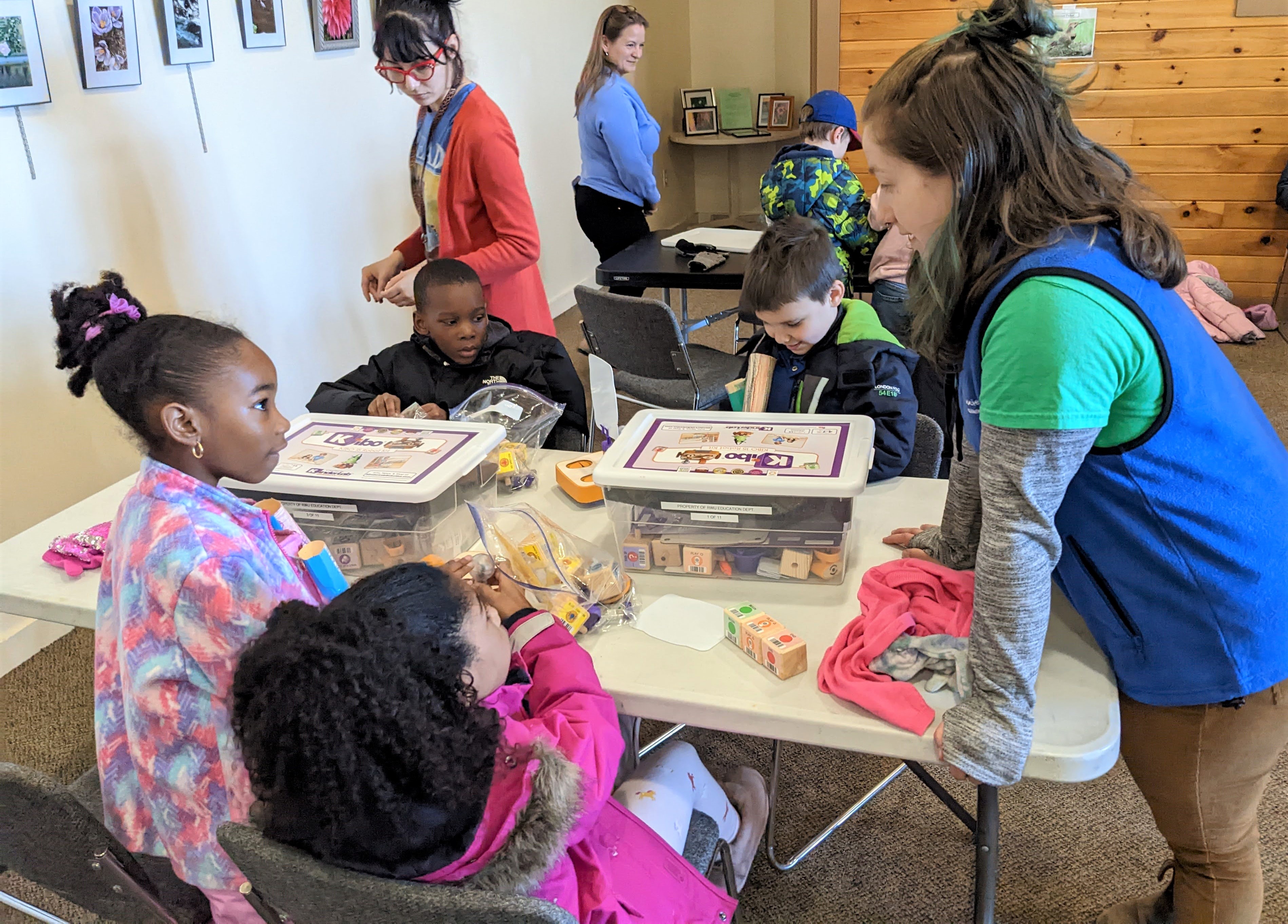
Next Steps: Collaboration Outcomes
Sustainability was another integral part of the planning of this service learning project. I developed this project for preservice teachers as part of my coding course that I teach every year. Ideally, I would like to do this project every semester. I am hopeful that we can make this program a twice-a-year event with preservice teachers teaching students using robotics and integrating STEM with the science programs at the nature center (Figure 14). The elementary teachers, university, robotics company, and nature center showed excitement about continuing this partnership in the future and expanding to new projects as well.
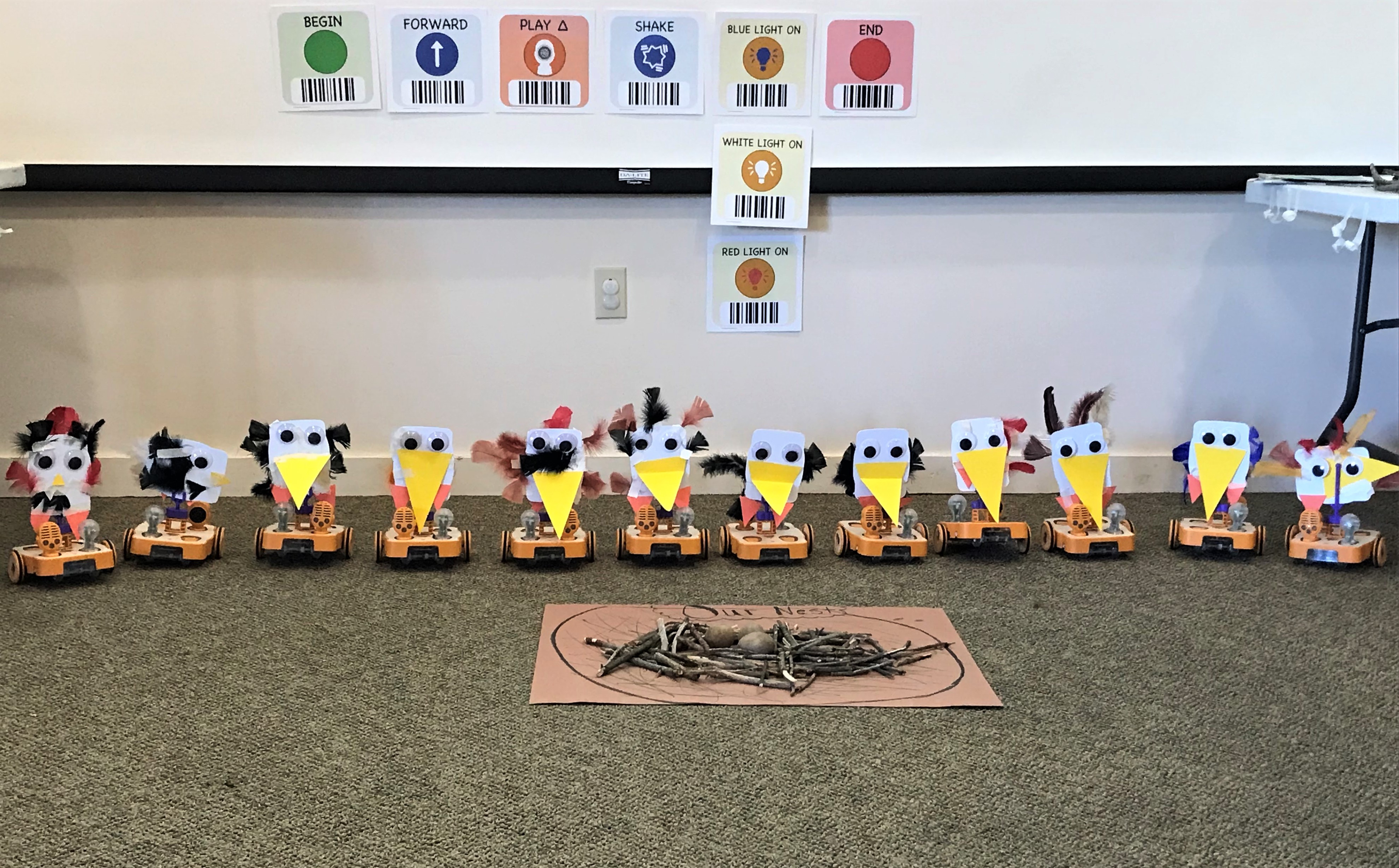
Conclusion
Integrating STEM—specifically outdoor, place-based learning, and coding and robotics—into the elementary classroom is beneficial for the students, educators, and community members involved. The elementary grades are an important time for students’ skills and interests to develop. The integration of STEM into the elementary curriculum will enhance student learning and engagement through the highly motivating interactions with real-world science and integrated with robotics and coding. Results from qualitative and quantitative data showed that the elementary students, preservice teachers, and community members from the nature center and the local robotics company involved in this project greatly benefited from the positive impact this integrated STEM program created.
This project also illustrates the power of collaboration within a community. Connecting with experts can give preservice and inservice educators the confidence to teach STEM in their own classrooms. And, involving inservice educators helps to ensure that these STEM learning experiences are relevant and connected to classroom learning. With the common goal of connected integrated STEM for elementary students, long-lasting partnerships were formed to create a significant impact on our community. I believe that, with some planning, any school, district, university, or local organization could follow our blueprint to integrate robotics, STEM, and local partners to benefit students in their own communities.
Katherine Marie Blagden, M. Ed., is a Visiting Assistant Professor at Roger Williams University in Bristol, Rhode Island.
NGSS Preservice Science Education STEM Technology Elementary Informal Education



